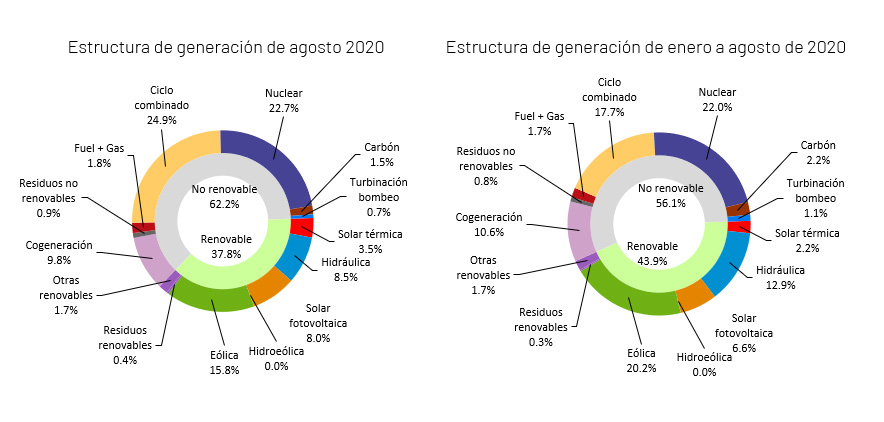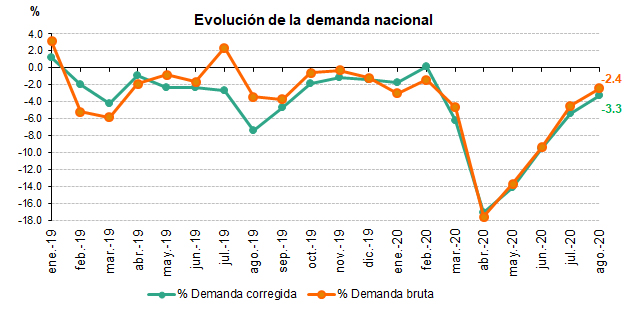37.8% of the monthly generation was of renewable origin: wind energy 15.8%, concentrated solar power 3.5% and photovoltaic 8%.61.2% was produced from technologies that do not emit equivalent CO₂.The demand for electricity decreased in the Balearic Islands by 19.7% and in the Canary Islands by 8% compared to the same month in 2019.
Photovoltaic solar energy continues to increase its weight in energy production nationwide. The accumulated generation as of August 3 (9,288 GWh) already exceeded that registered in the whole of 2019. At the end of the month the figure reached 10,932 GWh.

Red Eléctrica de España publishes the electricity demand for August, the second full month after the end of the alarm status due to Covid-19. In this context, the national electricity demand for August is estimated at 22,158 GWh, 2.4% lower than that registered in the same month of the previous year. If the effects of the calendar and temperatures are taken into account, the figure drops 3.3% compared to August 2019.
The decrease this month is less marked than that of the previous ones compared to the same period of 2019, and continues to show a gradual recovery in terms of energy consumption, given that during the period of the state of alarm (from March 15 to June 21 ), demand was 13.3% lower in the Spanish electricity system compared to the same period in 2019.
In the first eight months of 2020, demand is estimated at 165,549 GWh, 6.9% less than in 2019. In this case, once the influence of calendar and temperatures has been corrected, demand is 7.1% lower to that registered in the same period of the previous year.
 In August and, according to data estimated to date, generation from renewable energy sources represented 37.8% of production. During the first eight months of the year, renewable generation reached 43.9% of the national electricity balance. In August, 61.2% of electricity production came from technologies that do not emit CO2 equivalent.
In August and, according to data estimated to date, generation from renewable energy sources represented 37.8% of production. During the first eight months of the year, renewable generation reached 43.9% of the national electricity balance. In August, 61.2% of electricity production came from technologies that do not emit CO2 equivalent.
With information available today, solar photovoltaics continues to increase its weight in energy production nationwide. The accumulated generation as of August 3 (9,288 GWh) already exceeded that registered in all of 2019. At the end of the month, this figure reached 10,932 GWh.
For its part, wind generation in August reached 3,593 GWh, 24.3% more than in the same period last year, and accounted for 15.8% of national production, ranking as the third technology in the mix generation after the combined cycle and nuclear.
In the peninsular electricity system, the demand for August is estimated at 20,825 GWh, 1.7% lower than that registered in the same month of the previous year. If the effects of the calendar and temperatures are taken into account, the demand is 2.6% lower than that of August 2019.
In the first eight months of 2020, the demand for electricity in the Peninsula is estimated at 156,625 GWh, 6.5% less than in 2019. In this case, once the influence of the calendar and temperatures has been corrected, the demand it is also 6.7% lower than that registered in the same period of the previous year.
During this month and according to data estimated today, 38.8% of the peninsular generation was of renewable origin and 63.4% came from technologies that do not emit CO2 equivalent. For its part, wind power registered 3,421 GWh, 25.2% higher than in August last year, and contributed 15.9% to the mix.
The demand for electrical energy fell by 19.7% in the Balearic Islands and 8% in the Canary Islands in August
In the Balearic Islands, the demand for electricity in August is estimated at 565,899 MWh, 19.7% lower than that registered in the same month of the previous year. If the effects of the calendar and temperatures are taken into account, the figure drops 20.2% compared to August 2019. In the first eight months of 2020, Balearic demand is estimated at 3,368,224 MWh, a 20, 1% less than in the same period of 2019.
The combined cycle, with 71.5% of the total, was the first source of electricity generation in the Balearic Islands, where renewable energies generated in the archipelago and that do not emit equivalent CO2 represented 6%. For the eighth consecutive month, coal did not produce any MWh in the Balearic electricity system.
For its part, in the Canary archipelago the demand for electricity is estimated at 725,935 MWh, 8% lower than that registered in the same month of the previous year. If the effects of the calendar and temperatures are taken into account, the figure drops 8.4% compared to August 2019. In the first eight months of 2020, the Canarian electricity demand is estimated at 5,281,989 MWh, a 10 % lower compared to the same period in 2019.
The combined cycle, with 31.1% of the total, was the main source of electricity generation in the Canary Islands. Renewables and emission-free technologies accounted for 27.9% of production.
http://helionoticias.es/la-demanda-de-energia-electrica-de-espana-desciende-un-24-en-agosto/


